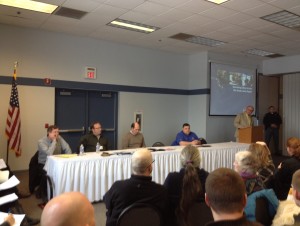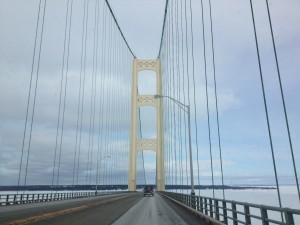
Editor’s note: Learn more about FLOW’s efforts to shut down Line 5 and stop the proposed oil pipeline tunnel on FLOW’s Line 5 program page and new Line 5 fact sheet.
The public will have a last chance on October 6 to comment orally to the leadership and staff of the U.S. Army Corps of Engineers, Detroit District, on the agency’s plans for a study of an oil tunnel proposed under the Great Lakes.
The Army Corps will hold an online meeting from 1-4 p.m. on Thursday to help set the scope of the agency’s environmental impact statement study of a proposal by Enbridge, Inc., of Canada, to build an oil tunnel under the Straits of Mackinac. The tunnel would house Enbridge’s Line 5 oil pipeline, which has leaked dozens of times across Michigan and Wisconsin while carrying oil since 1953 from western Canada primarily to refineries in Sarnia, Ontario. The Army Corps study is expected to continue through at least 2023.
Enbridge, Inc., of Canada, to build an oil tunnel under the Straits of Mackinac. The tunnel would house Enbridge’s Line 5 oil pipeline, which has leaked dozens of times across Michigan and Wisconsin while carrying oil since 1953 from western Canada primarily to refineries in Sarnia, Ontario. The Army Corps study is expected to continue through at least 2023.
 In addition to the Oct. 6 meeting, the public can comment on the study of the tunnel proposal by October 14 by mail or the Army Corps project website. The Oil & Water Don’t Mix campaign, of which FLOW is a founding steering committee member, also is collecting and forwarding comments to the Army Corps using an email template that suggests key points to make. FLOW’s preliminary tunnel comment also provides critical elements to convey.
In addition to the Oct. 6 meeting, the public can comment on the study of the tunnel proposal by October 14 by mail or the Army Corps project website. The Oil & Water Don’t Mix campaign, of which FLOW is a founding steering committee member, also is collecting and forwarding comments to the Army Corps using an email template that suggests key points to make. FLOW’s preliminary tunnel comment also provides critical elements to convey.
Many Troubling Aspects of the Tunnel Proposal
Enbridge wants to bore and blast a 20-foot-in-diameter tunnel under the Straits of Mackinac, just west of the Mackinac Bridge, to house a new Line 5 pipeline. The Canadian company’s stated goal is to continue for another 99 years carrying up to 23 million gallons of oil and natural gas liquids a day through Line 5 and State of Michigan public trust bottomlands where Lake Michigan meets Lake Huron, just west of the Mackinac Bridge.
Canadian company’s stated goal is to continue for another 99 years carrying up to 23 million gallons of oil and natural gas liquids a day through Line 5 and State of Michigan public trust bottomlands where Lake Michigan meets Lake Huron, just west of the Mackinac Bridge.
FLOW and our partners have identified critical deficiencies in the project’s construction permit application, its legal authorization, and the review by State of Michigan environmental agencies of expected impacts to wetlands, bottomlands, and surface water, including from the daily discharge of millions of gallons of wastewater during construction. FLOW and our allies have expressed continuing concerns about the impact to the Great Lakes and lack of public necessity for the project, which would worsen climate change by adding greenhouse gas emissions each year equivalent to almost seven new coal-fired power plants or nearly 6 million new cars to the road, according to experts.
Enbridge also lacks adequate liability insurance, according to a report released by the Attorney General Dana Nessel’s office revealing that Enbridge’s subsidiaries, not its parent company, hold Line 5’s 1953 easement and signed the proposed tunnel agreement; the assets of the subsidiaries’ parent Enbridge are inadequate to cover the costs and economic damages in the event of a moderate spill.
At Prior Army Corps Hearing, a Strong Majority Rejected the Proposed Oil Tunnel
The Army Corps already has held a Sept. 1 online comment session to help scope its tunnel study and a Sept. 8 in-person hearing in St. Ignace, where more than 4 out of 5 people who spoke, from among a crowd of hundreds, said that an oil pipeline tunnel proposed under the Great Lakes was a dangerous idea that would rob future generations by threatening the most precious thing on earth—fresh water—and worsening the climate crisis.

Hundreds of people attend a public comment session held by the U.S. Army Corps of Engineers on the oil pipeline tunnel proposed by Enbridge under the Straits of Mackinac, on Sept. 8, 2022, at Little Bear East Arena in St. Ignace, Michigan. Photo by Kelly Thayer.
Most commenters at the seven-hour, St. Ignace hearing expressed deep concern for the harm that construction or a potential explosion or spill from the operation of an oil pipeline tunnel could have on their children and grandchildren’s future, local residents, the Great Lakes, drinking water, tourist economy, and jobs—as well as tribal rights, tribal member survival, cultural heritage, the fishery, ecology of the Straits of Mackinac, and the climate. (Read FLOW’s coverage here).
FLOW’s Position on the Scope of the Army Corps Tunnel Study
FLOW’s position, as expressed at the hearing in St. Ignace, is that the Army Corps’ environmental study of the tunnel proposal and alternatives must under the law include, at a minimum:
- A “no action” alternative that would use existing capacity in other pipelines and, if necessary, other transportations solutions—such as rail and truck transport of natural gas liquids—in lieu of building new pipeline infrastructure.
- An alternative to connect Enbridge’s Superior, Wisc., and Sarnia, Ontario, terminals without crossing the Great Lakes. (See FLOW’s fact sheet on alternatives).
- A tunnel alternative that fully eliminates the risk of oil intrusion into the Straits in the event of an explosion or similar event.
Army Corps Process to Continue through at Least 2023
Enbridge has applied for a Army Corps permit under the Rivers and Harbors Act of 1899 and the Clean Water Act, seeking federal approval to discharge dredged or fill materials into waters of the United States, as well as the construction of structures or work that may affect navigable waters. The Army Corps also will conduct an ethnographic/traditional cultural landscape study as part of the environmental impact statement under the National Historic Preservation Act. After considering public comment and issuing the draft EIS likely by fall 2023, the Army Corps will seek additional public feedback, release a final study, and then issue a “record of decision” regarding whether to issue, issue with modification, or deny the Department of the Army permit altogether—consistent with the National Environmental Policy Act.
The Army Corps, Detroit District, to date has identified general concerns in the following categories:
- Potential direct effects to waters of the United States including wetlands; water and sediment quality; aquatic species and fisheries; threatened and endangered species;
- Archaeological and cultural resources, including the Straits as a Traditional Cultural Landscape; Tribal treaty rights and interests;
- Recreation and recreational resources; waste management; aesthetics; noise; air quality; climate change, including greenhouse gas emissions and the social cost of greenhouse gasses;
- Public health and safety during construction and operations; navigation; erosion; invasive species; energy needs; environmental justice; needs and welfare of the people; and cumulative effects.
FLOW’s Legal Team and Allies Helped Spur the Army Corps’ Full Environmental Study
FLOW continues to be deeply engaged in every step of the Army Corps study and committed to shutting down Line 5 and stopping the oil tunnel. FLOW’s legal team and allies helped spur the Army Corps’ full Environmental Study through our legal research, analysis, and comment, including FLOW’s formal legal comments submitted to the agency in July 2020. The legal team challenged the proposed tunnel in December 2020 by submitting comprehensive comments to the U.S. Army Corps of Engineers calling for an environmental impact statement on behalf of a dozen organizations: Chippewa Ottawa Resource Authority, Clean Water Action—Michigan, FLOW, Groundwork Center, League of Women Voters of Michigan, Michigan Environmental Council, Michigan League of Conservation Voters, NMEAC, Sierra Club Michigan Chapter, Straits Area Concerned Citizens for Peace, Justice and Environment, Straits of Mackinac Alliance, and TC 350. The comments demonstrated a serious gap in Enbridge’s evaluation of the presence of loose, unconsolidated rock and sediment in the bottom of the Straits of Mackinac that Enbridge has characterized as solid bedrock.






















